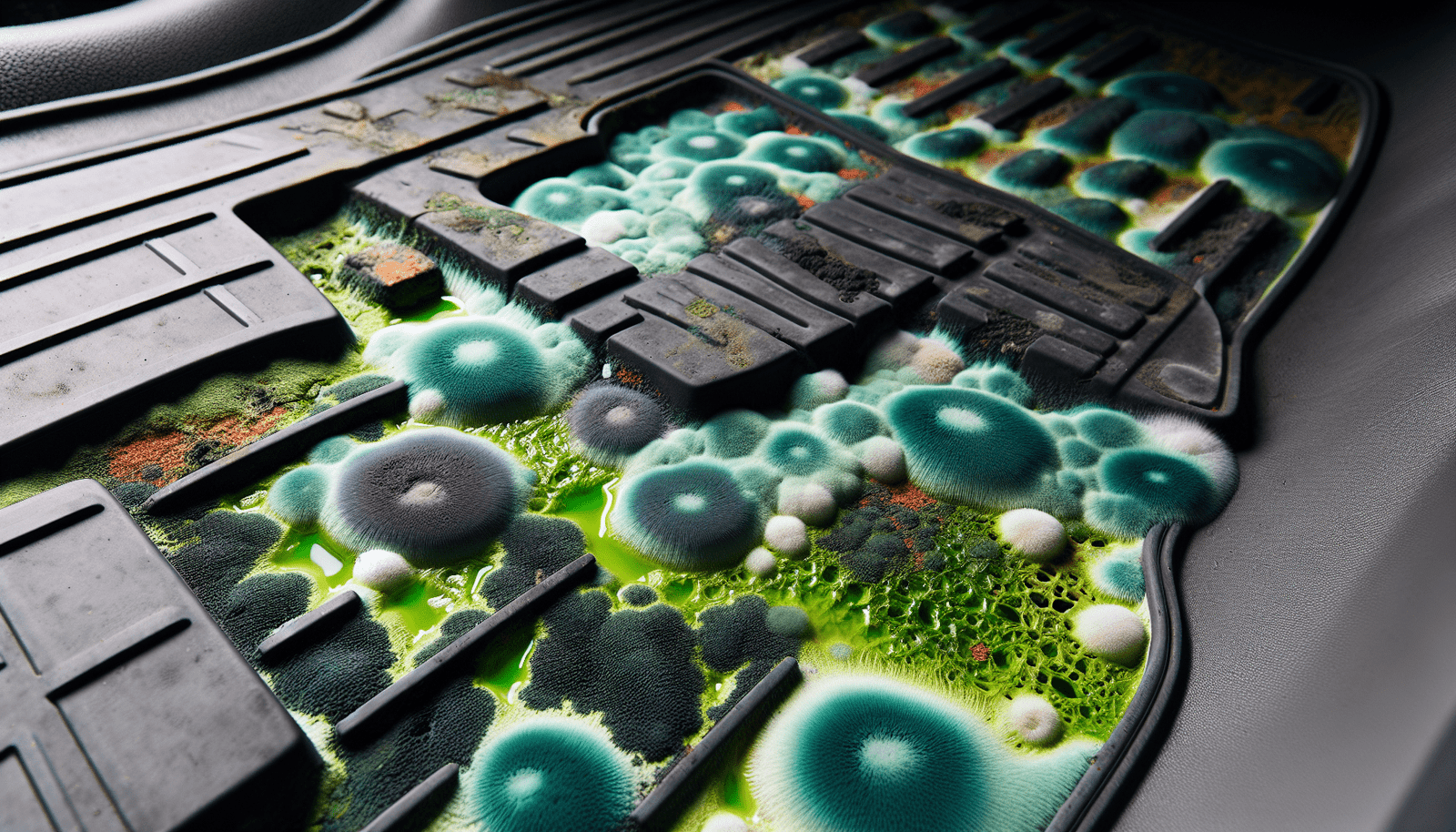If you’re an automobile enthusiast or in search of reliable floor mats, you’ve probably wondered, “Do rubber mats get moldy?” Mold can be a nuisance, especially when it comes to maintaining the cleanliness and durability of your beloved car accessories. In this article, we’ll address this frequently asked question and provide you with all the information you need to keep your rubber mats in pristine condition. So let’s dive right in and discover how to protect your mats from the dreaded mold and ensure a long-lasting investment for your vehicle.
Mold Formation Overview
Understanding What Mold Is
Mold is a type of fungus that can grow both indoors and outdoors. It reproduces by producing spores, which are tiny and lightweight and can easily travel through the air. Mold spores can be found everywhere, but they only grow into mold colonies when they find the right conditions to thrive. Mold requires moisture, warmth, and a food source to grow.
The Process of Mold Growth
Mold growth begins with the presence of mold spores in the environment. When these spores come into contact with moisture, they can start to grow and form colonies. As they grow, they release more spores into the air, which can spread the mold to other areas. Mold growth can occur on various surfaces, including rubber mats, if the conditions are favorable.
Conditions that Encourage Mold Growth
Damp and Humid Environment
Mold thrives in damp and humid environments. If your rubber mats are constantly in contact with moisture or are placed in an area with high humidity levels, such as a bathroom or basement, they are more likely to develop mold. Moisture can come from sources like water spills, excessive sweating, or even humidity in the air.
Amount of Light
Mold prefers dark environments. If your rubber mats are placed in a dimly lit area where sunlight cannot reach them, it creates an ideal environment for mold growth. Sunlight has natural disinfectant properties that can help prevent mold.
Temperature Ranges
Mold prefers warm temperatures between 77°F (25°C) and 86°F (30°C). Cooler temperatures can slow down mold growth, but it can still occur. Rubber mats stored in areas with consistent warmth provide an environment suitable for mold to thrive.
Air Circulation
Poor air circulation can contribute to mold growth. If your rubber mats are in an enclosed space with limited airflow, such as a closet or under furniture, it can create a stagnant environment where moisture becomes trapped. Good air circulation helps to prevent mold by allowing surfaces to dry more quickly.
Rubber Material and Mold
Definition and Properties of Rubber
Rubber is a versatile material made from the sap of rubber trees or synthetic sources. It is known for its elasticity, durability, and resistance to various environmental factors. Rubber can be found in a wide range of products, including rubber mats.
Resistance of Rubber to Mold
Rubber is generally resistant to mold growth because it is not a suitable food source for mold. Mold requires organic materials, such as wood or fabric, to grow and sustain itself. However, while rubber itself may be resistant to mold, it doesn’t make rubber mats immune to mold growth if the right conditions are present.
Can Rubber Mats Get Moldy?
Factors that Can Make Rubber Attractive to Mold
Although rubber mats are not an ideal food source for mold, several factors can make rubber attractive to mold. One such factor is the presence of dirt, dust, or organic debris on the rubber surface. These can serve as food sources for mold spores and help facilitate their growth.
Instances Where Mold Can Grow on Rubber Mats
Rubber mats can become susceptible to mold growth if they are continuously exposed to moisture or high humidity levels. This can happen in areas like bathrooms, basements, or even outdoor environments where rain or moisture is prevalent. If the rubber mats are not properly cleaned or maintained, mold can find a suitable surface to grow on.
Preventing Mold Growth on Rubber Mats
Proper Cleaning and Maintenance
Regular cleaning and maintenance are essential for preventing mold growth on rubber mats. Here are some tips to keep your mats mold-free:
- Clean the mats regularly with a mild soap or detergent and warm water. Scrub the surface gently using a soft brush to remove any dirt or organic debris.
- Thoroughly rinse the mats to remove all the soap residue.
- Allow the mats to dry completely before placing them back in their designated area.
- Avoid using harsh chemicals or abrasive cleaning agents, as they can damage the rubber and make it more susceptible to mold growth.
- Consider using an anti-fungal or mold-resistant spray specifically designed for rubber mats to provide an extra layer of protection.
Ideal Storage Conditions
Proper storage is crucial to prevent moisture buildup and mold growth on rubber mats. Here are some guidelines to follow:
- Store rubber mats in a dry and well-ventilated area.
- Avoid storing them in damp or humid environments, such as basements or areas prone to water leaks.
- If the mats are wet, allow them to dry completely before storing them.
- Consider using elevated storage racks or hanging the mats to promote airflow and prevent moisture accumulation underneath.
Signs of Mold on Rubber Mats
Visual Signs of Mold Growth
Visual signs of mold growth on rubber mats include the appearance of green, black, or brown patches on the surface. Mold can also appear fuzzy, slimy, or have a powdery texture. It may spread across the mat or form clusters in specific areas. If you notice any discoloration on your rubber mats, it’s crucial to inspect them for mold growth.
Smell and other Indications
In addition to visual signs, mold on rubber mats can also produce a musty or unpleasant odor. If you detect a moldy smell coming from your mats, it may indicate the presence of mold. Other indications of mold growth can include an increase in allergies or respiratory symptoms when using or being near the mats.
The Dangers of Mold on Rubber Mats
Health Hazards
Exposure to mold on rubber mats can pose health hazards, especially for individuals with allergies or respiratory conditions. Mold spores can cause allergic reactions, such as sneezing, coughing, and itchy eyes, in susceptible individuals. Prolonged exposure or inhaling large amounts of mold spores can contribute to more severe respiratory issues.
Damage to Rubber Mats
Mold growth can damage rubber mats by breaking down the material and causing discoloration. Over time, mold can weaken the rubber and lead to cracks or deterioration. If left unaddressed, mold can permanently damage rubber mats, reducing their lifespan and effectiveness.
Removing Mold from Rubber Mats
Preparation and Safety Measures
Before removing mold from rubber mats, it’s essential to take proper precautions:
- Put on protective gear, such as gloves, a mask, and safety goggles, to minimize exposure to mold spores.
- Work in a well-ventilated area to ensure adequate airflow.
- If possible, move the mats outdoors to prevent the spread of mold spores inside.
Cleaning Techniques and Solutions
To remove mold from rubber mats, follow these steps:
- Begin by vacuuming the mats to remove loose mold spores and debris.
- Create a cleaning solution by mixing one part vinegar with one part water or by using a commercial mold cleaner designed for rubber surfaces.
- Apply the cleaning solution to the affected areas using a sponge or soft brush.
- Gently scrub the moldy spots, ensuring you reach all the crevices.
- Rinse the mats thoroughly with clean water to remove any residue.
- Allow the mats to air dry completely before returning them to their proper location.
Post Cleaning Procedures
After cleaning mold-infected rubber mats, it’s crucial to prevent future mold growth:
- Inspect the mats regularly to ensure mold has not returned.
- Keep the mats clean and dry by following the proper cleaning and maintenance techniques mentioned earlier.
- If necessary, repeat the cleaning process or consider using mold-resistant products to provide ongoing protection.
Selecting Mold-Resistant Rubber Mats
Considerations when Buying Rubber Mats
When choosing rubber mats to minimize the risk of mold growth, consider the following factors:
- Look for mats specifically advertised as mold-resistant or anti-fungal.
- Opt for mats with non-porous surfaces that are less likely to trap moisture.
- Check for mats that have good drainage capabilities to prevent water pooling on the surface.
- Consider the mat size, thickness, and durability to ensure it fits your specific needs.
Recommended Brands and Products
While there are various brands and products available, some popular options for mold-resistant rubber mats include:
- Brand A: Their rubber mats are engineered with mold-resistant properties and come in various sizes and patterns.
- Brand B: Their antimicrobial rubber mats have a unique surface that inhibits the growth of mold and bacteria.
- Brand C: They offer rubber mats specially designed for high-moisture environments, making them resistant to mold and mildew.
Rubber Mat Care Tips and Tricks
Maintaining Your Rubber Mats
To keep your rubber mats in optimal condition and minimize the risk of mold growth, follow these care tips:
- Regularly sweep or vacuum your mats to remove loose debris.
- Wipe up any spills or moisture promptly to prevent moisture accumulation.
- Avoid exposing the mats to extreme temperatures or prolonged sunlight, as it can accelerate deterioration.
- Rotate or reposition the mats periodically to promote even wear and airflow.
- Consider using a UV protectant spray to shield the mats from sunlight damage.
- Store the mats properly when not in use, following the storage guidelines mentioned earlier.
Useful Resources and Guides
For more information on caring for rubber mats or dealing with mold, the following resources can be helpful:
- “The Complete Guide to Rubber Mat Maintenance” – A comprehensive guide that provides tips and techniques for maintaining rubber mats and preventing mold growth.
- “Dealing with Mold: A Step-by-Step Guide” – An in-depth resource that offers detailed instructions on identifying, removing, and preventing mold growth on various surfaces, including rubber.
- “The Benefits of Mold-Resistant Flooring” – An informative article explaining the advantages of using mold-resistant flooring options, including rubber mats.
In conclusion, while rubber mats themselves are generally resistant to mold, they can still be susceptible to mold growth if the right conditions are present. By understanding the factors that encourage mold growth, implementing proper cleaning and maintenance practices, and considering mold-resistant options, you can prevent and address mold issues effectively. Taking care of your rubber mats not only ensures their longevity but also promotes a clean and healthy environment.





